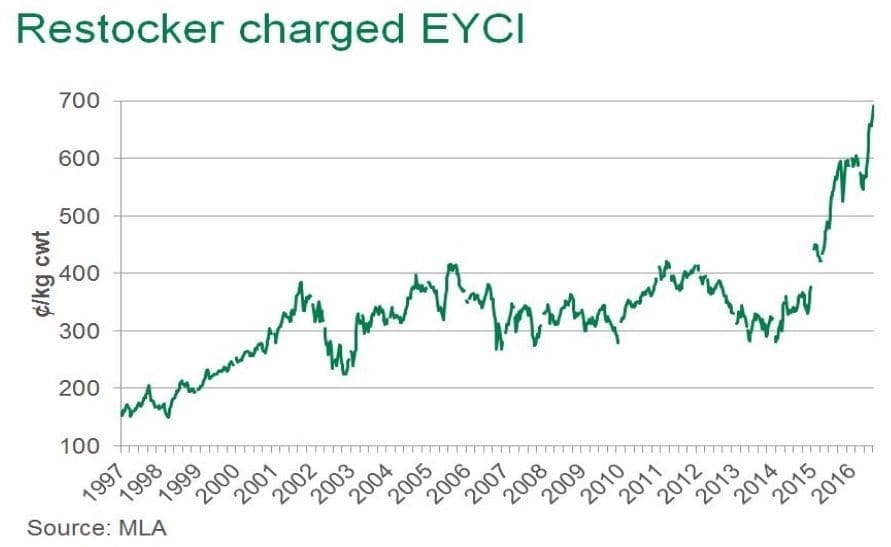
THE Eastern Young Cattle Indicator reached an unheralded 692.25c/kg this afternoon, threatening to break through the 700c barrier in coming days for the first time since the barometer was established in 1997.
The result is up 18.25c on this time last week, +34c in the past month, and an unbelievable 126.75c on this time last year.
Apart from a single day back in early March, the indicator only really broke through the 600c barrier seven weeks ago, in mid-June. The sharp rising trend is due to the powerful combination of heavy unseasonal rain, on top of a national cattle herd at 20-year lows after two years of drought.
Numerous saleyards across the eastern states this week registered record individual sale prices yet again. All were at the younger spectrum of the market. In fact, EYCI-eligible cattle reported by NLRS (C2 and C3 vealer and yearling steers and heifers) averaged more than 700¢/kg at numerous selling centres throughout the week.
These included:
- Monday: Wagga (702¢)
- Tuesday: CTLX Carcoar (728¢), Gunnedah (710¢), Roma Store (703¢) and Scone (713¢)
- Wednesday: Singleton (720¢)
- Thursday: Dubbo (725¢)
On top of this, EYCI cattle at TRLX Tamworth and NVLX Wodonga were within 20¢ of the 700¢ mark.
Restocker share well up, processor share down
As outlined in MLA’s recently-released July cattle industry half-year projections, restockers have been the driving force behind the EYCI bolting through the 600’s during June and July. This is demonstrated through the proportion of EYCI purchases from restockers in July accounting for 41pc, up from 34pc in the same month last year.
At the same time, lotfeeders have held their own, consistently accounting for 44pc of EYCI cattle bought for the past four months. Interestingly, processors usually account for 29pc of the July EYCI purchases (on a five-year average), but during July 2016, they collectively bought only 15pc.
This is the lowest proportion of processor EYCI acquisitions in at least six years, and clearly highlighted where the cattle market strength is being generated, MLA said, in commentary this afternoon.
Also representative of the small national herd, saleyard throughput has been tracking well below long-term averages, and for the first week of August offerings were 44,622 head, down 11pc from the five-year average of 50,067 head.
Similarly, weekly eastern states cattle slaughter for the last week of July was 124,630 head – down 14pc from the corresponding long-term average.
Looking forward, three things typically happen to the EYCI from August to the end of spring (November), MLA said.
Prices ease. In seven out of the past ten years, the EYCI averaged lower in November compared to August – ranging from a decline of 2pc to 20pc. The only three increases were modest – 1pc in 2010, 5pc in 2011 and 3pc in 2015 – and these were all very wet years.
Restockers take a step back. Some 80pc of the time, restockers have purchased a lower proportion of EYCI cattle, offset by a rise from feedlots. Interestingly, restockers purchased less in each of three wet years mentioned above.
Processors purchase fewer EYCI cattle at the end of spring compared to the end of winter.
“Whether or not these trends occur in 2016 remain to be seen, but if the average price decline were to be repeated, the EYCI would remain in the mid-600¢/kg territory,” MLA said.
“The trend least likely to occur, for the first time, is processors taking any further steps back in the number of EYCI cattle purchased – especially considering the very low proportion of acquisitions they are currently making.”
“The biggest unknown though, and the dictator of where the EYCI eventually reaches a maximum price, is the depth of restocker pockets – which continue to surprise,” MLA said.
Source: MLA, industry contacts
